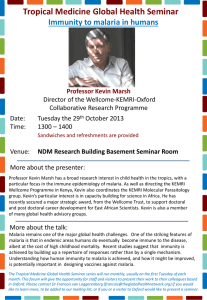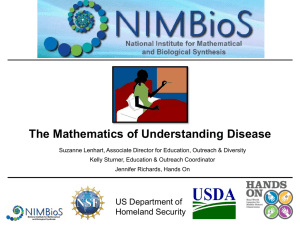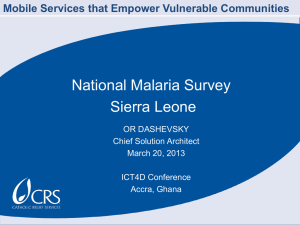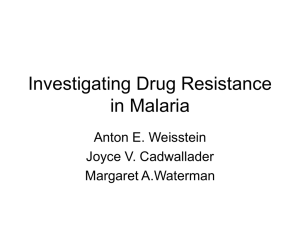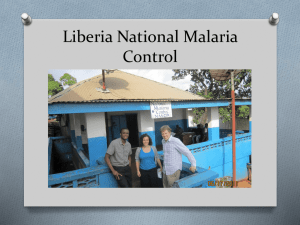MALARIA
advertisement
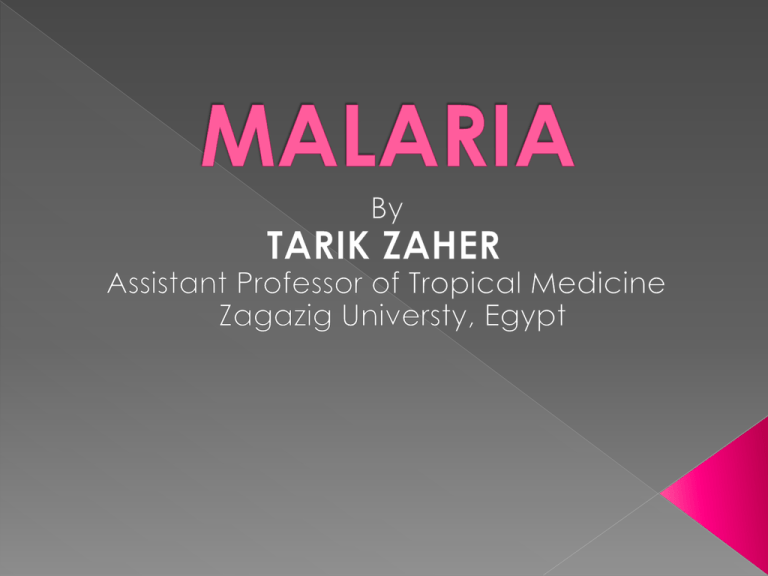
Malaria, the 'King of Diseases‘ Affects more than 500 million and kills more than 3 million people every year. Malarial belt. A, B and C. Plasmodia=malaria parasites Malaria is caused by protozoan parasites called Plasmodia, belonging to the parasitic phylum Apicomplexa. More than 200 species of the genus Plasmodium (=plasma + eidos, form) have been identified that are parasitic to reptiles, birds, and mammals. Four Plasmodium species have been well known to cause human malaria, namely, P. falciparum, P. vivax, P. ovale, and P. malariae. A fifth one, P. knowlesi, has been recently documented to cause human infections in many countries of Southeast Asia. P. falciparum P. vivax P. ovale P. malariae P. knowlesi Distribution 80-90% of cases in Africa, 40-50% of cases in western pacific and SE Asia, 4-30% in S Asia, S America and rest of tropics 70-90% of cases in most of Asia and S America, 5060% of cases in SE Asia and western pacific, 110% in Africa 8% of cases in parts of Africa, stray cases in Asia 2-3% in Africa, sporadic in Asia and S America Reported from SE Asia; 70% of cases in some of those areas Tissue schizogony 5-6 days 8 days 9 days 13 days 8-9 days Erythrocytic phase 48 hours 48 hours 49-50 hours 72 hours 24 hours Red cells affected All Reticulocyte Reticulocyte Mature RBC's ? Merozoites per tissue schizont 40000 Over 10000 15000 2000 ? Merozoites per red cell schizont 8-32 12-24 4-16 6-12 10-16 Relapse from persistent liver forms No Yes (hypnozoit) Yes (hypnozoit) No, but blood forms can persist up to 30 years No Fever pattern Tertian, sub tertian Tertian Tertian Quartan Quotidian Severe malaria Up to 24% Up to 22% Very rare Very rare 6-10% Drug resistance Yes Yes No No No Ring Forms of P. falciparum Ring Forms of P. vivax Ring Forms of P. ovale Ring Forms of P. malariae Ring Forms of P. knowlesi Vector: pregnant female Anopheles mosquito Cytokines, cytoadherence and rosetting Atypical features is more than typical. Malaria can mimic any thing and every thing. Cold stage, Hot stage and Sweating stage. The febrile episode starts with shaking chills, usually at mid-day between 11 a.m. to 12 noon, and this lasts from 15 minutes to 1 hour (the cold stage), followed by high grade fever, even reaching above 1060 F, which lasts 2 to 6 hours (the hot stage). This is followed by profuse sweating and the fever gradually subsides over 2-4 hours. These typical features are seen after the infection gets established for about a week. The febrile paroxysms are usually accompanied by head aches, vomiting, delirium, anxiety and restlessness. In an endemic area, it is rather unusual to find cases with typical fever pattern. Some patients may not have fever at all and may present with other symptoms listed below. Many present with fever of various patterns - low grade to high grade, with or without chills, intermittent to continuous, or even as cases of prolonged fever. In the initial stages of the illness, fever may be quotidian, with more than one spike per day and this is due to the development of multiple broods of the parasite. As the disease progresses, these broods get synchronised and the fever tends to be more uniform. However in cases of P. falciparum malaria and mixed infections, this pattern of multiple spikes may continue. Headache. Body ache, back ache and joint pains. Dizziness, vertigo. Altered behaviour, acute psychosis. Altered sensorium. Convulsions, coma. Cough. Breathlessness. Chest pain. Acute abdomen. Weakness. Vomiting and diarrhoea. Jaundice. Pallor. Puffiness of lids. Secondary infections. Hepatosplenomegaly. Due to P.falciparum. Death from acute P. vivax, P. ovale or P. malariae infections is rare. 1. Cerebral malaria – unrousable coma not attributable to any other cause in a patient with falciparum malaria. The coma should persist for at least 30 min (1 h in the 2000 definition) after a generalized convulsion to make the distinction from transient postictal coma. Coma should be assessed using the Blantyre coma scale in children or the Glasgow coma scale in adults . 2. Severe anaemia – normocytic anaemia with haematocrit <15% or haemoglobin <5 g/dL in the presence of parasitaemia more than 10 000/μL. Note that finger prick samples may underestimate the haemoglobin concentration by up to 1 g if the finger is squeezed. If anaemia is hypochromic and/or microcytic, iron deficiency and thalassaemia/haemoglobinopathy must be excluded. (These criteria are rather generous; and would include many children in high transmission areas. A parasitaemia of >100 000/μL might be a more appropriate threshold.) 3. Renal failure – defined as a urine output of <400 mL in 24 h in adults, or 12 mL/kg in 24 h in children, failing to improve after rehydration, and a serum creatinine of more than 265 μmol/L (>3.0 mg/dL). (In practice for initial assessment, the serum creatinine alone is used.) 4. Pulmonary oedema or adult respiratory distress syndrome. 5. Hypoglycaemia – defined as a whole blood glucose concentration of less than 2.2 mmol/L (40 mg/dL). 6. Circulatory collapse(Algid malaria) or shock – hypotension (systolic blood pressure <50 mmHg in children aged 1–5 years or <70 mmHg in adults), with cold clammy skin or core-skin temperature difference >10°C. (The more recent review declined to give precise definitions, but noted the lack of sensitivity or specificity of core-peripheral measurements.) Capillary refill time is not mentioned but recent studies indicate this simple test provides a good assessment of severity 7. Spontaneous bleeding from gums, nose, gastrointestinal tract, etc. and/or substantial laboratory evidence of DIC. (This is relatively unusual.) 8. Repeated generalized convulsions – more than two observed within 24 h despite cooling. (In young children, these may be febrile convulsions, and the other clinical and parasitological features need to be taken into account.) Clinical evidence of seizure activity may be subtle (e.g. tonic clonic eye movements, profuse salivation, delayed coma recovery). 9. Acidaemia – defined as an arterial or capillary pH <7.35 (note temperature corrections are needed as most patients are hotter than 37°C; add 0.0147 pH unit per degree Celsius (°C) over 37°C), or acidosis defined as a plasma bicarbonate concentration <15 mmol/L or a base excess >10. (Operationally, the clinical presentation of ‘respiratory distress' or ‘acidotic breathing’ is focused upon in the 2000 recommendations. Abnormal breathing patterns are a sign of severity indicating severe acidosis, pulmonary oedema or pneumonia.) 10. Macroscopic haemoglobinuria (Black water fever)– if definitely associated with acute malaria infection and not merely the result of oxidant antimalarial drugs in patients with erythrocyte enzyme defects such as G6PD deficiency. (This is difficult to ascertain in practice: if the G6PD status is checked following massive haemolysis, the value in the remaining red cells may be normal even in mild G6PD deficiency. This part of the definition is not very useful.) 11. Postmortem confirmation of diagnosis. In fatal cases a diagnosis of severe falciparum malaria can be confirmed by histological examination of a postmortem needle necroscopy of the brain. The characteristic features, found especially in cerebral grey matter, are venules/capillaries packed with erythrocytes containing mature trophozoites and schizonts of P. falciparum. (These features may not be present in patients who die several days after the start of treatment, although there is usually some residual pigment in the cerebral vessels.) The 2000 recommendations also include the following: 12. Impairment of consciousness less marked than unrousable coma. (Any impairment of consciousness must be treated seriously. Assessment using the Glasgow Coma Scale is straightforward, but the Blantyre Scale needs careful local standardization particularly in younger children.) 13. Prostration: Inability to sit unassisted in a child who is normally able to do so. In a child not old enough to sit, this is defined as an inability to feed. This definition is based on examination not history. 14. Hyperparasitaemia – the relation of parasitaemia to severity of illness is different in different populations and age groups, but in general very high parasite densities are associated with increased risk of severe disease, e.g. >4% parasitaemia is dangerous in non-immunes, but may be well tolerated in semi-immune children. In non-immune children studied in Thailand a parasitaemia ≥4% carried a 3% mortality (30 times higher than in all uncomplicated malaria) but in areas of high transmission values much higher may be tolerated well. Many use a threshold definition of 10% parasitaemia in higher transmission settings. The followings were not considered criteria of severe malaria: Jaundice – detected clinically or defined by a serum bilirubin concentration >50 μmol/L (3.0 mg/dL). This is only a marker of severe malaria when combined with evidence of other vital organ dysfunction such as coma or renal failure. Hyperpyrexia – a rectal temperature above 40°C in adults and children is no longer considered a sign of severity. Repeat blood film(MPS) many times to catch diagnosis Peripheral smear examination for malarial parasite is the gold-standard in confirming the diagnosis of malaria. Thick and thin smears prepared from the peripheral blood are used for the purpose. The immunochromatographic tests for the detection of malaria antigens, developed in the past decade, have opened a new and exciting avenue in malaria diagnosis. However, their role in the management and control of malaria appears to be limited at present. Chloroquine resistant is now worldwide. Age in years Dose of Chloroquine (as base) (Each 250 mg tablet contains 150 mg base and each 5 ml of suspension contains 50 mg base) Dose of Primaquine For 14 days (P. vivax and P. ovale only) 1st dose (Tab) 2nd dose (Tab) 8h 3rd dose (Tab) 24 h 4th dose (Tab) 48 h 0-1 75 mg (½) 37.5 mg (¼) 37.5 mg (¼) 37.5 mg (¼) Nil 1-5 150 mg (1) 75 mg (½) 75 mg (½) 75 mg (½) 2.5 mg 5-9 300 mg (2) 150 mg (1) 150 mg (1) 150 mg (1) 5 mg 9-14 450 mg (3) 225 mg (1½) 225 mg (1½) 225 mg (1½) 10 mg >14 600 mg (4) 300 mg (2) 300 mg (2) 300 mg (2) 15 mg 0h Dosing of Artesunate + Mefloqine (WHO, 2010) Age Dose of Artesunate (50mg) Tablet Dose of Mefloquine (250mg) Tablet 5-11 months HALF tablet once daily for 3 days HALF tablet on second day ≥1-6 years ONE tablet once daily for ONE tablet on second 3 days day ≥7-13 years TWO tablets once daily for 3 days TWO tablets on second day, ONE tablet on third day >13 years FOUR tablets once daily for 3 days FOUR tablets on second day, TWO tablets on third day Dosing of Artemether + Lumefantrine Tablets (WHO, 2010) Weight (kgs) Age (years) Dose (No. of 20/120mg tablet) Twice daily for 3 days 5-14 <3 20/120 (1 tablet) 15-24 3-8 40/240 (2 tablets) 25-34 9-14 60/360 (3 tablets) >35 >14 80/480 (4 tablets) Dosing of Artemether + Lumefantrine Suspension Weight (kg) Dose of suspension (5 ml containing 15 mg artemether and 90 mg lumefantrine) once daily for 3 days 5 7 ml 5-7.5 10 ml 7.5-10 14 ml 10-15 20 ml First trimester :Quinine + Clindamycin for 7 days. ACT should be used if it is the only effective treatment available. Second and third trimesters :ACT known to be effective in the country/region or artesunate + clindamycin to be given for 7 days or quinine + clindamycin to be given for 7 days. Treatment of Severe P. falciparum Malaria First Drug Follow-on Treatment (Full course of any ACT) Artesunatea 2.4 mg/kg bw iv or im on admission; then at 12 h and 24 h, then once a day for at least 24 hours, followed by full course of ACT •Artesunate plus Sulfadoxine-pyrimethamine •Artesunate plus Amodiaquine •Artesunate plus clindamycin or doxycycline [See below for dose] OR Artemetherb 3.2 mg/kg bw i.m. given on admission then 1.6 mg/kg bw per day for at least 24 hours, followed by full course of ACT Artemether plus Lumefantrine Quinineb,c 20 mg salt/kg bw on admission (iv infusion or divided im injection), then 10 mg/kg bw every 8 h; infusion rate should not exceed 5 mg salt/kg bw per hour; course for 3 days for malaria acquired in Africa and South America, 7 days for malaria acquired in SE Asia Doxycyclined 100mgs BID (2.2mg/kg BID for <45kgs[5]) for 7 days OR Clindamycin 20mg base/kg/day divided in three doses for 7 days[5] in pregnancy Quinidine gluconatec 10 mg salt/kg (equivalent to 6.2 mg base/kg) iv infused over 1–2 hours, followed immediately by 0.02 mg/kg/min salt (equivalent to 0.0125 mg/kg/min base) continuous iv infusion; course for 3 days for malaria acquired in Doxycycline OR Clindamycin as above a.Recommended by WHO in low transmission areas or outside malaria endemic areas. b.Recommended by WHO for children in high transmission areas; regimen 1 can also be used. c.For areas where artesunate or artemether are not available, mainly the US. National Vector Borne Disease Control Programe in India recommends quinine as the treatment for severe malaria in pregnancy. Loading dose should not be administered to patients who received quinine, quinidine, halofantrine, or mefloquine within the preceding 12 hours. d.Not for children below 8 years of age and pregnant women e.Mefloquine has important neuropsychiatric and cardiac adverse effects; not an ideal drug for pregnancy; cannot be used concomitantly with quinine or quinidine. f.For pregnant women. Clindamycin 5 mg/kg (usually 300 mg) po or iv every 8 hours can be administered if the patient is unable to take doxycycline. Insecticide treated bed nets. Repellents. Chemoprophylaxis. No 100% protection. Antimalarial chemoprophylaxis Weight adjusted dose for children Adult dose CHLOROQUINE-SENSITIVE MALARIA Chloroquine 5 mg base/kg weekly 300 mg base 3.5 mg/kg daily 200 mg base and/or Proguanil CHLOROQUINE-RESISTANT MALARIA Mefloquine 5 base/kg weekly 250 mg base 1.5 mg/kg daily 100 mg 0.5 mg base/kg daily with food 30 mg base 4/1.6 mg/kg daily 250/100 mg Or Doxycycline Or Primaquine Or Atovaquoneproguanil(Malaron) Chloroquine should not be taken by people with a history of seizures, generalized psoriasis or pruritus previously on chloroquine. b Mefloquine is not recommended for babies <3 months of age. Mefloquine should not be taken by people with psychiatric disorders, epilepsy, or those driving heavy vehicles, trains, aeroplanes etc. or deep sea diving. c Doxycycline may cause photosensitivity. Use of sunscreens is recommended.Not for childern under 8 years. d Chloroquine, pyrimethamine and proguanil are all considered safe in pregnancy, but are now largely ineffective against P. falciparum. Mefloquine is considered safe, although there are uncertainties as treatment use has been associated with stillbirth in one large series. Tetracyclines and primaquine are contraindicated in pregnancy (although some argue that they are safe in first trimester before the formation of fetal bones and dentition, and before the risk of acute fatty liver), and atovaquone-proguanil has not been evaluated. e The use of antimalarial prophylaxis by children living in an endemic area has been shown to reduce mortality; in The Gambia administration of pyrimethamine and dapsone (Maloprim) in the 1–4 year age group reduced mortality by 25%. a Malarial nephropathy(Quartan nephropathy). Tropical splenomegaly(hyper reactive malarial splenomegaly) syndrome. Chronic anemia . Failure to thrive. The nephrotic syndrome, with albuminuria, hypoalbuminaemia, oedema and variable renal impairment, is common in the tropics.Repeated or continuous P. malariae infection is associated with childhood nephrotic syndrome in West Africa and Papua New Guinea. In the past, quartan nephropathy was also described in eastern Asia. It has disappeared from countries where P. malariae has been eradicated, such as Guyana, where Giglioli first described the relationship between malaria and nephrosis. This is also known as the tropical splenomegaly syndrome. It occurs where transmission of malaria is intense and has been reported throughout the tropics. The highest incidence of hyper-reactive malarial splenomegaly (HMS) yet reported was in the Upper Watut Valley of Papua New Guinea, where 80% of adults and older children had large spleens. Genetic factors undoubtedly also play a role because within a malarious area the geographical distribution of HMS does not follow closely that of malaria transmission. In Ghana first degree relatives have a four times higher incidence of HMS than age and location matched controls. There is gross splenomegaly with normal architecture, and lymphocytic infiltration of the hepatic sinusoids with Kupffer cell hyperplasia. The massively enlarged spleen leads to hypersplenism with anaemia, leucopenia and thrombocytopenia. There is a polyclonal hypergammaglobulinaemia with high with high serum concentrations of IgM. High titres of malaria antibodies and a variety of autoantibodies (antinuclear factor, rheumatoid factor) are usually present. The hypergammaglobulinaemia is believed to result from polyclonal B-cell activation in the absence of adequate numbers of CD8+ suppressor T-cells, which have been removed by an antibody-dependent cytotoxic mechanism. Cell-mediated immune responses are otherwise normal. Immunoglobulin gene rearrangements have been demonstrated in a sub-group of patients with HMS. This indicates clonal lymphoproliferation and the potential for progression to malignant lymphoma or leukaemia.


